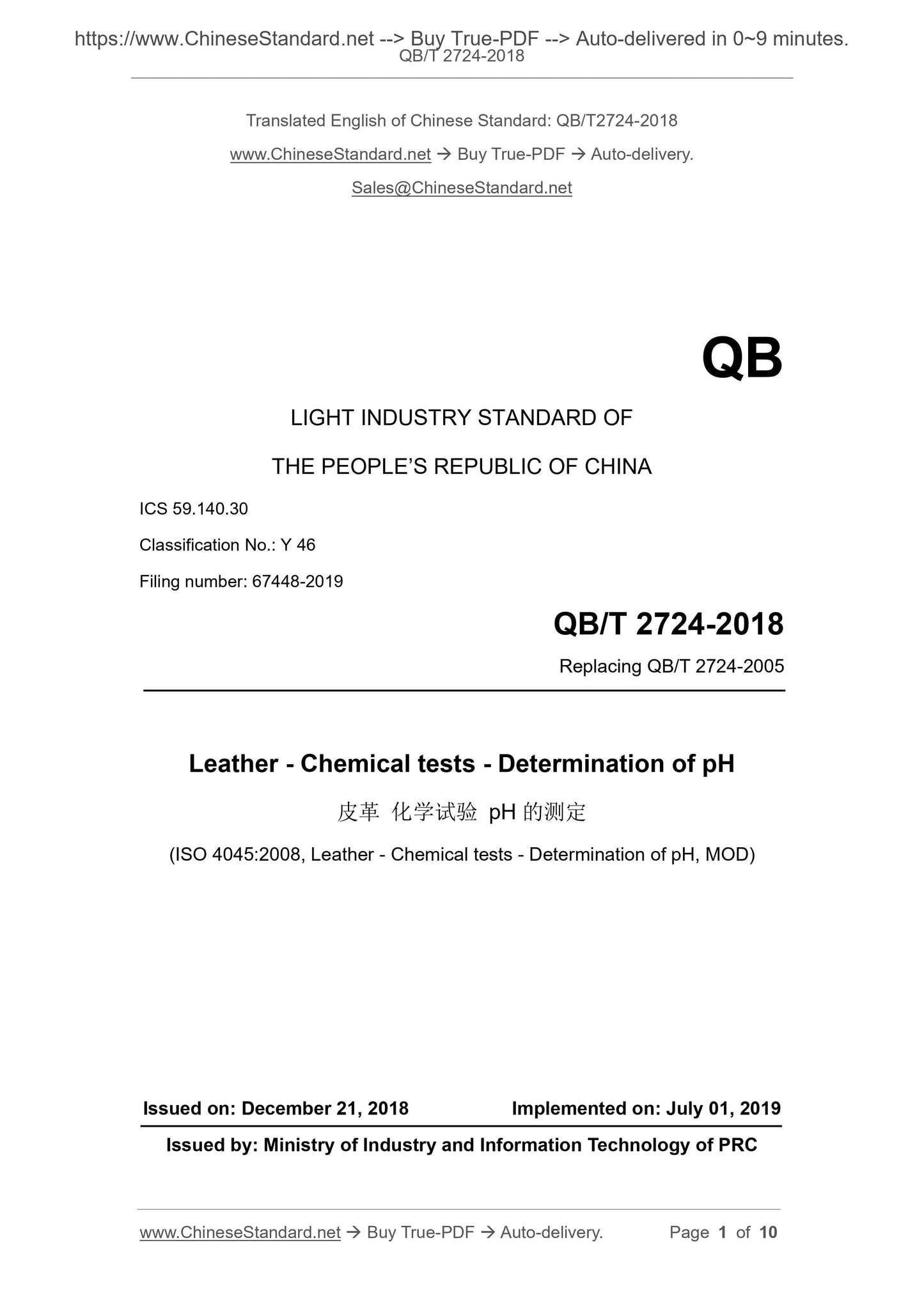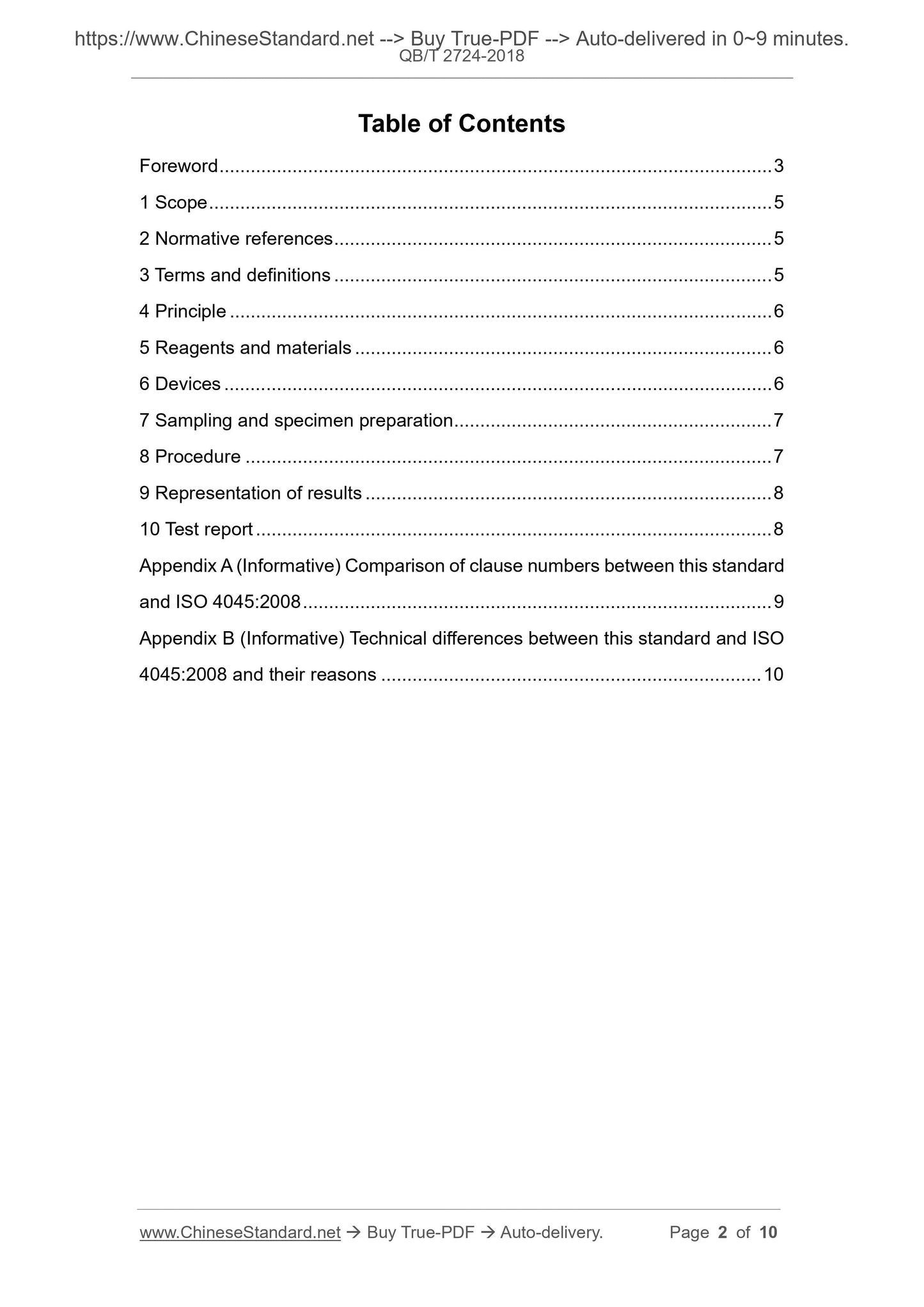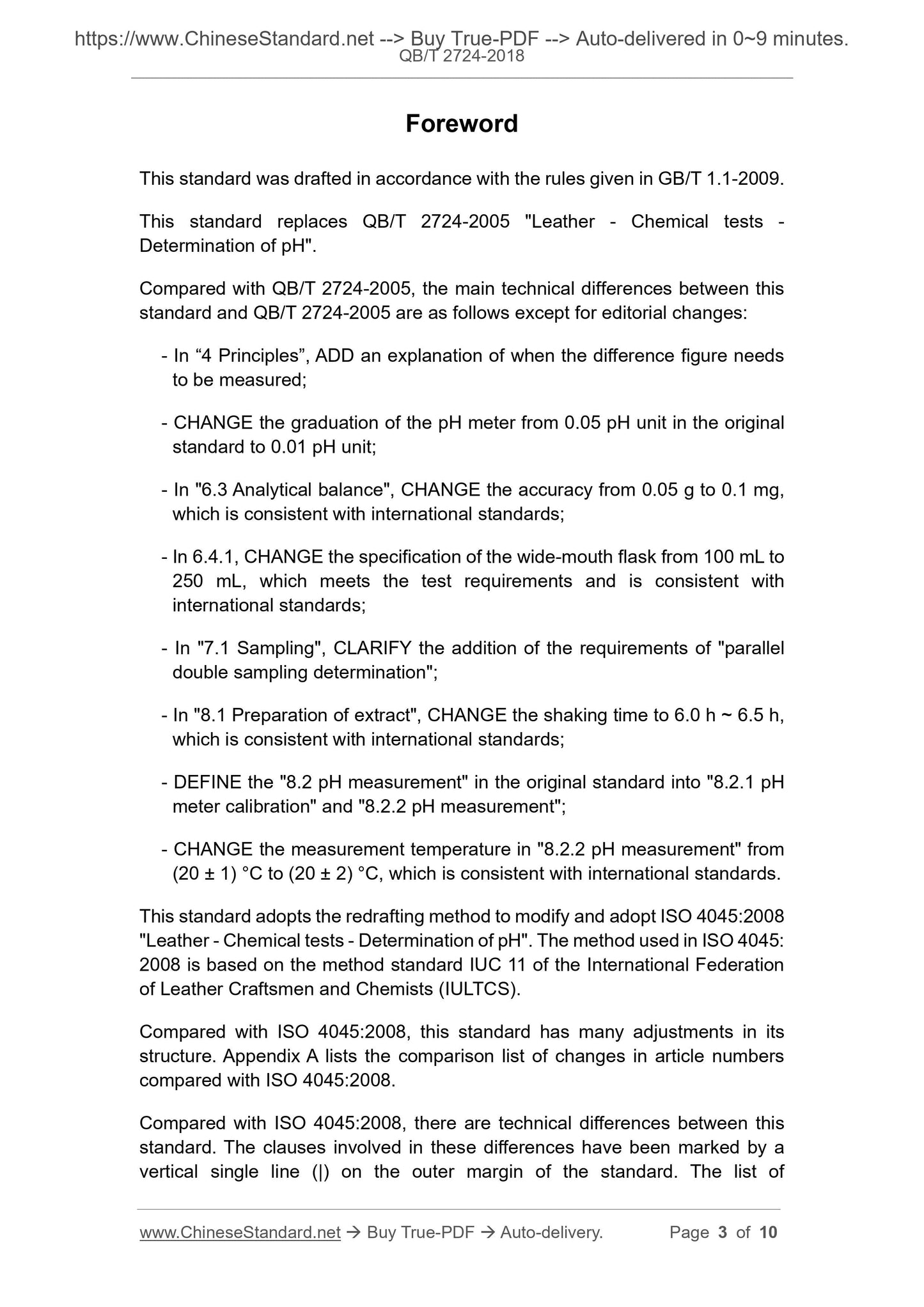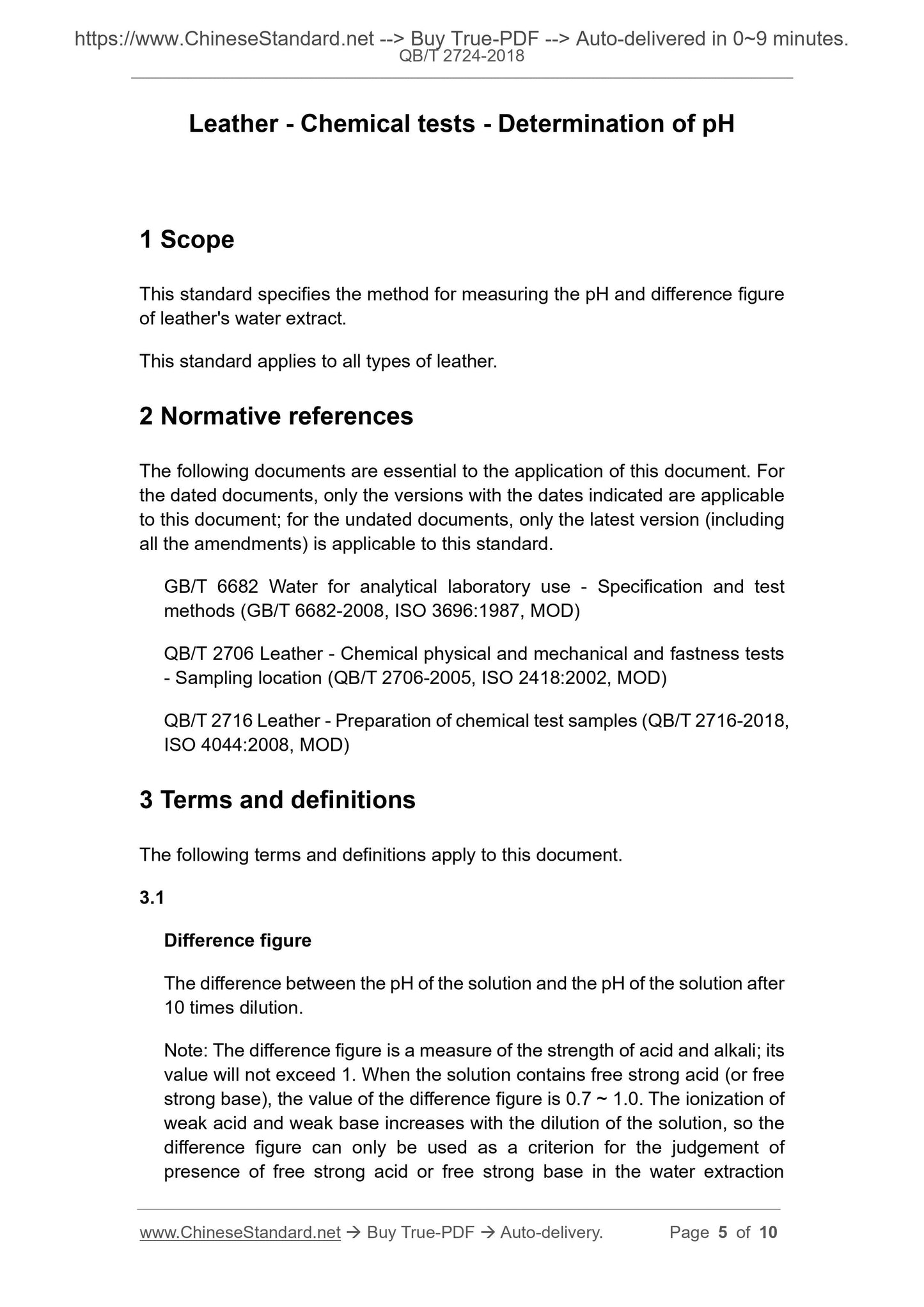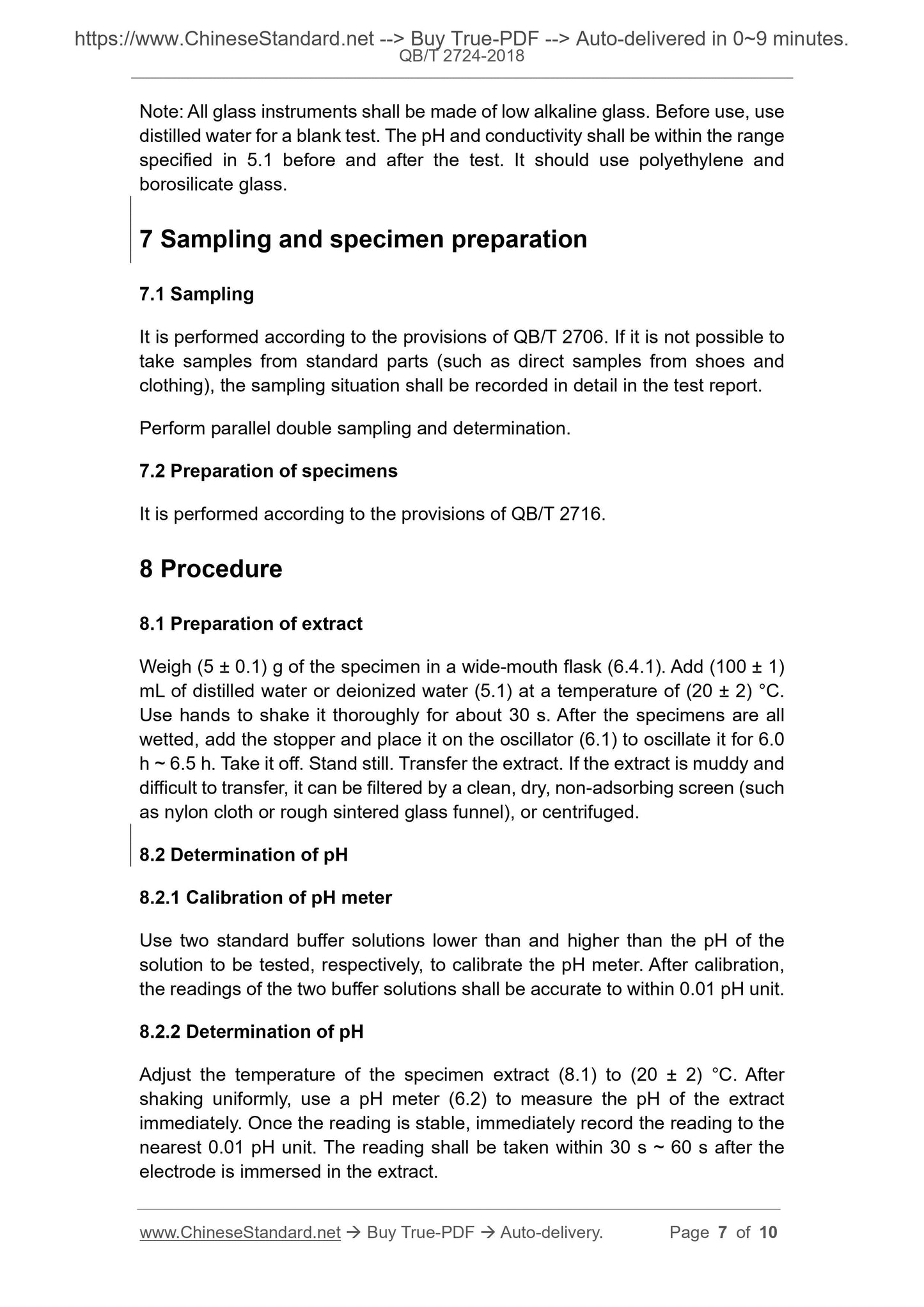1
/
of
5
PayPal, credit cards. Download editable-PDF and invoice in 1 second!
QB/T 2724-2018 English PDF (QBT2724-2018)
QB/T 2724-2018 English PDF (QBT2724-2018)
Regular price
$135.00 USD
Regular price
Sale price
$135.00 USD
Unit price
/
per
Shipping calculated at checkout.
Couldn't load pickup availability
Delivery: 3 seconds. Download true-PDF + Invoice.
Get QUOTATION in 1-minute: Click QB/T 2724-2018
Historical versions: QB/T 2724-2018
Preview True-PDF (Reload/Scroll if blank)
QB/T 2724-2018: Leather. Chemical tests. Determination of pH
QB/T 2724-2018
QB
LIGHT INDUSTRY STANDARD OF
THE PEOPLE’S REPUBLIC OF CHINA
ICS 59.140.30
Classification No.: Y 46
Filing number: 67448-2019
Replacing QB/T 2724-2005
Leather - Chemical tests - Determination of pH
(ISO 4045:2008, Leather - Chemical tests - Determination of pH, MOD)
ISSUED ON: DECEMBER 21, 2018
IMPLEMENTED ON: JULY 01, 2019
Issued by: Ministry of Industry and Information Technology of PRC
Table of Contents
Foreword ... 3
1 Scope ... 5
2 Normative references ... 5
3 Terms and definitions ... 5
4 Principle ... 6
5 Reagents and materials ... 6
6 Devices ... 6
7 Sampling and specimen preparation ... 7
8 Procedure ... 7
9 Representation of results ... 8
10 Test report ... 8
Appendix A (Informative) Comparison of clause numbers between this standard
and ISO 4045:2008 ... 9
Appendix B (Informative) Technical differences between this standard and ISO
4045:2008 and their reasons ... 10
Foreword
This standard was drafted in accordance with the rules given in GB/T 1.1-2009.
This standard replaces QB/T 2724-2005 "Leather - Chemical tests -
Determination of pH".
Compared with QB/T 2724-2005, the main technical differences between this
standard and QB/T 2724-2005 are as follows except for editorial changes:
- In “4 Principles”, ADD an explanation of when the difference figure needs
to be measured;
- CHANGE the graduation of the pH meter from 0.05 pH unit in the original
standard to 0.01 pH unit;
- In "6.3 Analytical balance", CHANGE the accuracy from 0.05 g to 0.1 mg,
which is consistent with international standards;
- In 6.4.1, CHANGE the specification of the wide-mouth flask from 100 mL to
250 mL, which meets the test requirements and is consistent with
international standards;
- In "7.1 Sampling", CLARIFY the addition of the requirements of "parallel
double sampling determination";
- In "8.1 Preparation of extract", CHANGE the shaking time to 6.0 h ~ 6.5 h,
which is consistent with international standards;
- DEFINE the "8.2 pH measurement" in the original standard into "8.2.1 pH
meter calibration" and "8.2.2 pH measurement";
- CHANGE the measurement temperature in "8.2.2 pH measurement" from
(20 ± 1) °C to (20 ± 2) °C, which is consistent with international standards.
This standard adopts the redrafting method to modify and adopt ISO 4045:2008
"Leather - Chemical tests - Determination of pH". The method used in ISO 4045:
2008 is based on the method standard IUC 11 of the International Federation
of Leather Craftsmen and Chemists (IULTCS).
Compared with ISO 4045:2008, this standard has many adjustments in its
structure. Appendix A lists the comparison list of changes in article numbers
compared with ISO 4045:2008.
Compared with ISO 4045:2008, there are technical differences between this
standard. The clauses involved in these differences have been marked by a
vertical single line (|) on the outer margin of the standard. The list of
Leather - Chemical tests - Determination of pH
1 Scope
This standard specifies the method for measuring the pH and difference figure
of leather's water extract.
This standard applies to all types of leather.
2 Normative references
The following documents are essential to the application of this document. For
the dated documents, only the versions with the dates indicated are applicable
to this document; for the undated documents, only the latest version (including
all the amendments) is applicable to this standard.
GB/T 6682 Water for analytical laboratory use - Specification and test
methods (GB/T 6682-2008, ISO 3696:1987, MOD)
QB/T 2706 Leather - Chemical physical and mechanical and fastness tests
- Sampling location (QB/T 2706-2005, ISO 2418:2002, MOD)
QB/T 2716 Leather - Preparation of chemical test samples (QB/T 2716-2018,
ISO 4044:2008, MOD)
3 Terms and definitions
The following terms and definitions apply to this document.
3.1
Difference figure
The difference between the pH of the solution and the pH of the solution after
10 times dilution.
Note: The difference figure is a measure of the strength of acid and alkali; its
value will not exceed 1. When the solution contains free strong acid (or free
strong base), the value of the difference figure is 0.7 ~ 1.0. The ionization of
weak acid and weak base increases with the dilution of the solution, so the
difference figure can only be used as a criterion for the judgement of
presence of free strong acid or free strong base in the water extraction
Note: All glass instruments shall be made of low alkaline glass. Before use, use
distilled water for a blank test. The pH and conductivity shall be within the range
specified in 5.1 before and after the test. It should use polyethylene and
borosilicate glass.
7 Sampling and specimen preparation
7.1 Sampling
It is performed according to the provisions of QB/T 2706. If it is not possible to
take samples from standard parts (such as direct samples from shoes and
clothing), the sampling situation shall be recorded in detail in the test report.
Perform parallel double sampling and determination.
7.2 Preparation of specimens
It is performed according to the provisions of QB/T 2716.
8 Procedure
8.1 Preparation of extract
Weigh (5 ± 0.1) g of the specimen in a wide-mouth flask (6.4.1). Add (100 ± 1)
mL of distilled water or deionized water (5.1) at a temperature of (20 ± 2) °C.
Use hands to shake it thoroughly for about 30 s. After the specimens are all
wetted, add the stopper and place it on the oscillator (6.1) to oscillate it for 6.0
h ~ 6.5 h. Take it off. Stand still. Transfer the extract. If the extract is muddy and
difficult to transfer, it can be filtered by a clean, dry, non-adsorbing screen (such
as nylon cloth or rough sintered glass funnel), or centrifuged.
8.2 Determination of pH
8.2.1 Calibration of pH meter
Use two standard buffer solutions lower than and higher than the pH of the
solution to be tested, respectively, to calibrate the pH meter. After calibration,
the readings of the two buffer solutions shall be accurate to within 0.01 pH unit.
8.2.2 Determination of pH
Adjust the temperature of the specimen extract (8.1) to (20 ± 2) °C. After
shaking uniformly, use a pH meter (6.2) to measure the pH of the extract
immediately. Once the reading is stable, immediately record the reading to the
nearest 0.01 pH unit. The reading shall be taken within 30 s ~ 60 s after the
electrode is immersed in the extract.
Get QUOTATION in 1-minute: Click QB/T 2724-2018
Historical versions: QB/T 2724-2018
Preview True-PDF (Reload/Scroll if blank)
QB/T 2724-2018: Leather. Chemical tests. Determination of pH
QB/T 2724-2018
QB
LIGHT INDUSTRY STANDARD OF
THE PEOPLE’S REPUBLIC OF CHINA
ICS 59.140.30
Classification No.: Y 46
Filing number: 67448-2019
Replacing QB/T 2724-2005
Leather - Chemical tests - Determination of pH
(ISO 4045:2008, Leather - Chemical tests - Determination of pH, MOD)
ISSUED ON: DECEMBER 21, 2018
IMPLEMENTED ON: JULY 01, 2019
Issued by: Ministry of Industry and Information Technology of PRC
Table of Contents
Foreword ... 3
1 Scope ... 5
2 Normative references ... 5
3 Terms and definitions ... 5
4 Principle ... 6
5 Reagents and materials ... 6
6 Devices ... 6
7 Sampling and specimen preparation ... 7
8 Procedure ... 7
9 Representation of results ... 8
10 Test report ... 8
Appendix A (Informative) Comparison of clause numbers between this standard
and ISO 4045:2008 ... 9
Appendix B (Informative) Technical differences between this standard and ISO
4045:2008 and their reasons ... 10
Foreword
This standard was drafted in accordance with the rules given in GB/T 1.1-2009.
This standard replaces QB/T 2724-2005 "Leather - Chemical tests -
Determination of pH".
Compared with QB/T 2724-2005, the main technical differences between this
standard and QB/T 2724-2005 are as follows except for editorial changes:
- In “4 Principles”, ADD an explanation of when the difference figure needs
to be measured;
- CHANGE the graduation of the pH meter from 0.05 pH unit in the original
standard to 0.01 pH unit;
- In "6.3 Analytical balance", CHANGE the accuracy from 0.05 g to 0.1 mg,
which is consistent with international standards;
- In 6.4.1, CHANGE the specification of the wide-mouth flask from 100 mL to
250 mL, which meets the test requirements and is consistent with
international standards;
- In "7.1 Sampling", CLARIFY the addition of the requirements of "parallel
double sampling determination";
- In "8.1 Preparation of extract", CHANGE the shaking time to 6.0 h ~ 6.5 h,
which is consistent with international standards;
- DEFINE the "8.2 pH measurement" in the original standard into "8.2.1 pH
meter calibration" and "8.2.2 pH measurement";
- CHANGE the measurement temperature in "8.2.2 pH measurement" from
(20 ± 1) °C to (20 ± 2) °C, which is consistent with international standards.
This standard adopts the redrafting method to modify and adopt ISO 4045:2008
"Leather - Chemical tests - Determination of pH". The method used in ISO 4045:
2008 is based on the method standard IUC 11 of the International Federation
of Leather Craftsmen and Chemists (IULTCS).
Compared with ISO 4045:2008, this standard has many adjustments in its
structure. Appendix A lists the comparison list of changes in article numbers
compared with ISO 4045:2008.
Compared with ISO 4045:2008, there are technical differences between this
standard. The clauses involved in these differences have been marked by a
vertical single line (|) on the outer margin of the standard. The list of
Leather - Chemical tests - Determination of pH
1 Scope
This standard specifies the method for measuring the pH and difference figure
of leather's water extract.
This standard applies to all types of leather.
2 Normative references
The following documents are essential to the application of this document. For
the dated documents, only the versions with the dates indicated are applicable
to this document; for the undated documents, only the latest version (including
all the amendments) is applicable to this standard.
GB/T 6682 Water for analytical laboratory use - Specification and test
methods (GB/T 6682-2008, ISO 3696:1987, MOD)
QB/T 2706 Leather - Chemical physical and mechanical and fastness tests
- Sampling location (QB/T 2706-2005, ISO 2418:2002, MOD)
QB/T 2716 Leather - Preparation of chemical test samples (QB/T 2716-2018,
ISO 4044:2008, MOD)
3 Terms and definitions
The following terms and definitions apply to this document.
3.1
Difference figure
The difference between the pH of the solution and the pH of the solution after
10 times dilution.
Note: The difference figure is a measure of the strength of acid and alkali; its
value will not exceed 1. When the solution contains free strong acid (or free
strong base), the value of the difference figure is 0.7 ~ 1.0. The ionization of
weak acid and weak base increases with the dilution of the solution, so the
difference figure can only be used as a criterion for the judgement of
presence of free strong acid or free strong base in the water extraction
Note: All glass instruments shall be made of low alkaline glass. Before use, use
distilled water for a blank test. The pH and conductivity shall be within the range
specified in 5.1 before and after the test. It should use polyethylene and
borosilicate glass.
7 Sampling and specimen preparation
7.1 Sampling
It is performed according to the provisions of QB/T 2706. If it is not possible to
take samples from standard parts (such as direct samples from shoes and
clothing), the sampling situation shall be recorded in detail in the test report.
Perform parallel double sampling and determination.
7.2 Preparation of specimens
It is performed according to the provisions of QB/T 2716.
8 Procedure
8.1 Preparation of extract
Weigh (5 ± 0.1) g of the specimen in a wide-mouth flask (6.4.1). Add (100 ± 1)
mL of distilled water or deionized water (5.1) at a temperature of (20 ± 2) °C.
Use hands to shake it thoroughly for about 30 s. After the specimens are all
wetted, add the stopper and place it on the oscillator (6.1) to oscillate it for 6.0
h ~ 6.5 h. Take it off. Stand still. Transfer the extract. If the extract is muddy and
difficult to transfer, it can be filtered by a clean, dry, non-adsorbing screen (such
as nylon cloth or rough sintered glass funnel), or centrifuged.
8.2 Determination of pH
8.2.1 Calibration of pH meter
Use two standard buffer solutions lower than and higher than the pH of the
solution to be tested, respectively, to calibrate the pH meter. After calibration,
the readings of the two buffer solutions shall be accurate to within 0.01 pH unit.
8.2.2 Determination of pH
Adjust the temperature of the specimen extract (8.1) to (20 ± 2) °C. After
shaking uniformly, use a pH meter (6.2) to measure the pH of the extract
immediately. Once the reading is stable, immediately record the reading to the
nearest 0.01 pH unit. The reading shall be taken within 30 s ~ 60 s after the
electrode is immersed in the extract.
Share
